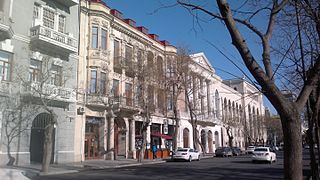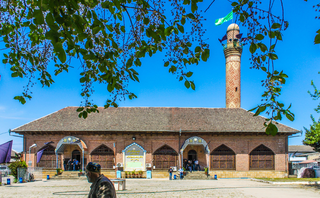
Sheikh Ibrahim mosque is a historical mosque, located on Asaf Zeynalli Street, in the Old City of Baku, in Azerbaijan.

Abdulhamid Bey Sharif Bey oglu Gaytabashi was the last Chief of General Staff of Azerbaijani Armed Forces of Azerbaijan Democratic Republic before its occupation by the Red Army in April 1920.
Musa bey Rafiyev Haji Mammadhuseyn oglu, also known as Musa bey Rafibeyli, was an Azerbaijani public, political, and state figure. He was a member of the Muslim faction of the Transcaucasian Sejm and the Azerbaijani National Council. He held ministerial positions in the second and fifth governments of the Azerbaijan Republic. Elected to the Azerbaijan Republic Parliament from the Musavat party, he served on the Finance and Budget Commission.

The Haji Bani Mosque is one of the mosques of Azerbaijan, was built in the sixteenth century. It is located in Old City, Baku.

Khanlar Mosque is a historical and architectural monument dating back to the 19th century, located in Old City, Baku.

Aydin Balamirza oghlu Mammadov is an Azerbaijani historian, scientist-demographer, specialist on historical demography, Ph.D. in history, and associate professor of the department of "source study, historiography and methods" of Baku State University. He is one of the 100 Notable alumni of Baku State University.

The Imam Hussein Mosque or Ashumov Mosque is a historical and architectural monument dating back to the 19th century. It is located in the city of Baku, Azerbaijan.

Khagani Alley is a road from Rasul Rza alley to Kovkab Khanim Safaraliyeva alley. There are many historical monuments of the 16th to 20th centuries on the street, as well as a statue and three parks. The road is 1.7 kilometres (1.1 mi) in length.

The Boyuk Bazar Mosque is a mosque in the city of Lankaran, Azerbaijan. The mosque was built in 1864 in the Boyuk Bazar neighborhood.

The Kichik Bazar Mosque is a mosque and historical architectural monument located in the center of the Lankaran district of Azerbaijan. The mosque was built in 1904.

Khoja Marjanly's Spring is a historical spring located in the city of Shusha, in the Khoja Marjanly neighbourhood, near the mosque with the same name. It was built in the 18th century. Since the occupation of Shusha by the Armenian forces on 8 May 1992, the spring was in a neglected state and eventually dried up.

Elchin Safarali oglu Babayev is an Azerbaijani scientist, Doctor of Philosophy in physical and mathematical Sciences, associate professor. Rector of Baku State University

Javad bey Mammad agha oghlu Shikhlinski was an officer of the Tsarist army, a major general of the Azerbaijan Republic Army, and the commander of the Ardabil garrison in the Qajar army.

The Chalabilar Mosque is a former mosque and historical architectural monument, located in the village of Chalabilar in Jabrayil district of Azerbaijan. Completed in 1678, the former mosque was included in the list of local significant immovable historical and cultural monuments by decision No. 132 of the Cabinet of Ministers of the Republic of Azerbaijan on August 2, 2001.

Ismail Khan Ziyadkhanov or Ismail Khan Ziyadkhanly was a member of the government of the Azerbaijan Democratic Republic, a diplomat, and a lieutenant colonel in the army of the Azerbaijan Democratic Republic. He was one of the five Azerbaijanis elected to the First State Duma of the Russian Empire.

The Haji Badal Mosque is a mosque and historical architectural monument, located in the "Basqal" State Historical-Cultural Reserve in Azerbaijan. Completed in 1854, the mosque was included in the list of local importance immovable historical and cultural monuments by the 132nd decision of the Cabinet of Ministers of the Republic of Azerbaijan on August 2, 2001.

Hil mosque is a mosque located in the village of Hil in the Qusar district of Azerbaijan.

Gulluk Mosque also known as the Gulluk Juma Mosque, is a historical-architectural monument dating back to 1727. It is located in the village of Gulluk in the Qakh district of Azerbaijan.
Basgal Castle is a medieval fortress located in the Basgal settlement of Azerbaijan. It is considered the largest fortress discovered in Azerbaijan in terms of its area and the length of its walls.

Gulamrza Sharifzade also known as Gulamrza Sharifov, was an actor, director, publisher, and politician. He served as the director of the Azerbaijan State Theater in 1919–1920.



















